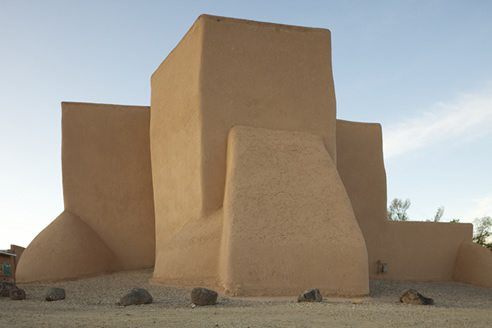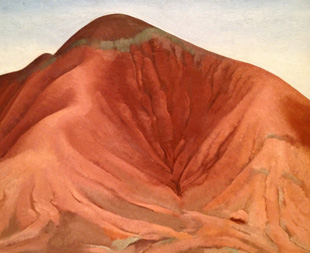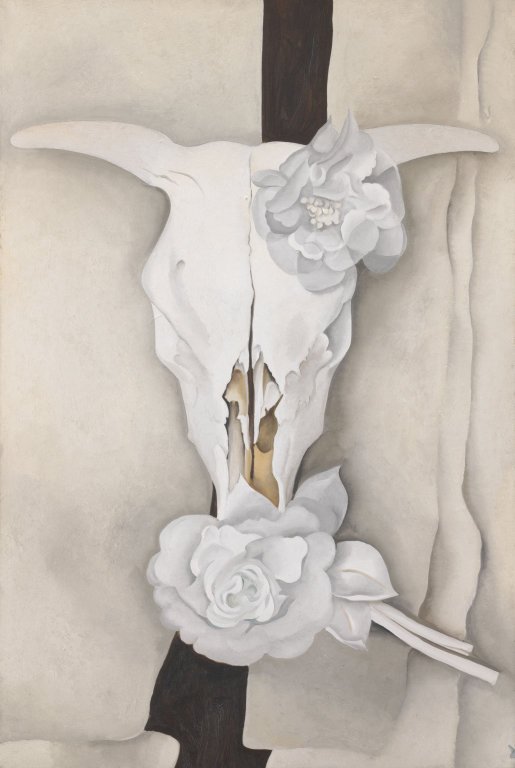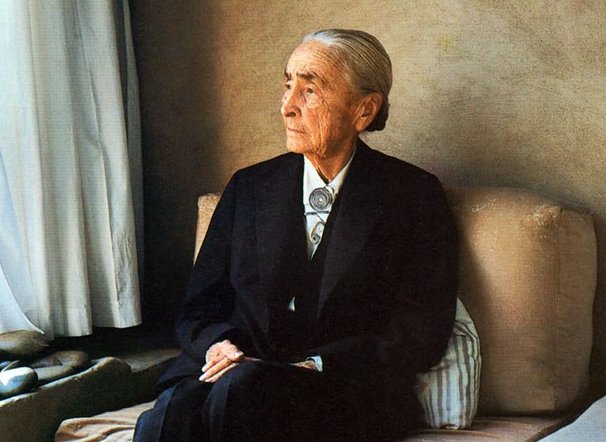
In this final look at the life and works of the American artist Georgia O’Keefe I want to examine her love affair with New Mexico and how it influenced her art. She had been living in New York during the winter months and in the summertime she and her husband, Alfred Stieglitz, would move to his large family home at Lake George in upstate New York. However by the end of the 1920’s Georgia had depicted all she could of the Lake George area and was looking for a new challenge, something fresh to influence her work. Her reason for giving up her summer sojourns at Lake George could well be that she had tired of having to share the space with Stieglitz’s family and friends, who also passed time at Lake George during the summer months. I already told you in the previous blog that in order to pacify Georgia, Stieglitz had agreed to her moving out of the large family home and live and work in a farm building on the estate, which she called her Shanty. The desire to move away from Lake George and Stieglitz could have been Georgia’s desire to escape the suffocation of Stieglitz’s family and friends but another reason could have been that she was having health problems as in 1927 she had to undergo two breast operations. Another contributory factor could be Georgia’s unhappiness at Stieglitz having become infatuated with a young woman Dorothy Norman, forty-four years his junior.

Fate took a hand in 1929. Her friend and fellow artist, Rebecca Strand, the wife of photographer, Paul Strand, who was a close friend of Alfred Stieglitz, suggested that she and Georgia take a trip to Santa Fe, New Mexico. Georgia liked the idea of escaping Lake George that summer and so in the May the two set off on the long train journey to the New Mexico town. Not long after arriving in Santa Fe, the two women received an invitation from Mabel Dodge Luhan, a wealthy American writer and patron of the arts, to come and visit her and stay a while at her large twelve-acre property in Taos, New Mexico. Mabel Luhan was a great hostess who liked to surround herself with artists and writers. Taos was a small town, situated on a high plateau in the north-central region of New Mexico, whose inhabitants at the time were mainly native Indians. It had become, since the beginning of the twentieth century, a favourite destination of artists because of its unspoiled landscape and clear light and in 1915 the Taos Society of Artists was formed. The English writer and playwright, D.H. Lawrence, fell in love with the area waxed lyrically on the effect it had upon him:
“…The moment I saw the brilliant proud morning shine high up over the deserts of Santa Fe, something stood still in my soul, and I started to attend. There was a certain magnificence in the high-up day, a certain eagle-like royalty……In the magnificence fierce morning of New Mexico one sprang awake, a new part of the soul woke up suddenly, and the old world gave way to a new…”
Georgia O’Keefe also could not have been happier with what she saw at Taos. Mabel Dodge Luhan had even provided her two visitors with a studio within her large house. Georgia found Taos and the surrounding area simply inspirational and so different from the places she had previously visited. She spent her time during her five-month stay wandering around the area visiting the small Indian villages on foot or sometimes on horseback constantly sketching and developing ideas for her work. Travelling by foot or horse restricted the distance she could travel so Georgia learned how to drive and bought herself a Ford Model A car, and from then on, distance was no longer a problem.

One of the places Georgia visited was the Kiowa Ranch, which was owned by Mabel Dodge Luhan and who had gifted it to the English writer D.H.Lawrence and his wife Frieda in 1924. It is situated near the town of San Cristobal, some twenty miles north west of Taos. It has become known as the D.H. Lawrence Ranch. One of the great natural phenomena on the ranch was the great pine tree, which stood in front of, and towered over the ranch house. This beautiful specimen became known as the Lawrence Tree, as he used to sit writing at a table at its base and in Rachel Maurer’s The D.H. Lawrence Ranch she quotes the English writer’s description of the tree he loved so much:
“…The big pine tree in front of the house, standing still and unconcerned and alive…the overshadowing tree whose green top one never looks at…One goes out of the door and the tree-trunk is there, like a guardian angel. The tree-trunk, the long work table and the fence…”
Georgia O’Keefe wonderfully captured the tree in her 1929 painting, The D.H. Lawrence Pine Tree. Of it, she said:
“… There was a long weathered carpenter’s bench under the tall tree in front of the little old house that Lawrence had lived in there. I often lay on that bench looking up into the tree…past the trunk and up into the branches. It was particularly fine at night with the stars above the tree…”
At first glance, the depiction of the tree almost resembles an octopus with its long tentacles stretching out amidst its ejected black ink. Once you look closer you begin to realise that what you are looking at are the branches of a tree as they stretch upwards into the cloudless night sky. Georgia achieved this depiction by painting it whilst lying down on a long carpenter’s bench at the base of the tree and looking up at the star-filled sky through its branches and the dark mass of pine needles. It is a beautifully evocative work of art. The painting now hangs at the Wadsworth Atheneum in Hartford, Connecticut.

Another place which fascinated O’Keefe during her 1929 visit to Taos was the San Francisco de Assisi Mission Church at Ranchos de Taos with its massive adobe buttresses and two front-facing bell towers,which was completed in 1816. This building is a National Historic Landmark, dating back to Spanish Colonial times.

It is a well-preserved adobe building in the heart of the community at the central plaza of the Ranchos de Taos Historic District and is re-mudded every spring. O’Keefe was fascinated by the buildings of the indigenous people and completed a series of six paintings featuring the church from different angles, some in the clear light of day with cloudless blue skies, others with a cloud covering.

O’Keefe wanted her work to highlight the natural harmony of the building with the surrounding nature and she has cleverly captured just that by merging the rounded forms of the sand coloured building with the similarly coloured ground.

From 1929 to 1949, O’Keefe regularly returned to New Mexico each summer although she found the growing artist colony of Taos at odds with her desire for isolation and tranquility and so in 1931 she began to spend her summers in the Rio Grande Valley, which lay west of Taos and rented a small cottage in the village of Alcalde. Georgia O’Keefe was fascinated by the barren landscape with its red sand hills and the flat-topped tablelands. This was the New Mexico Badlands, which was a type of arid terrain where softer sedimentary rocks and clay-rich soils had been considerably scoured by both wind and water.What she saw before her may have been inhospitable and infertile but it was the colours which fascinated her and inspired her paintings. Of this factor she once said:
“…All the earth colours of the painter’s palette are out there in the many miles of badlands. The light Naples yellow through the ochres – orange and red and purple earth – even the soft earth greens…”

In 1934 she completed a painting entitled Small Purple Hills, which depicts the stark, desolate and yet colourful rocky formation.
Another series of her paintings depicting the dark and forbidding landscape with its grey and black hills, was her series of paintings entitled The Black Place. They were depictions of the Bisti De-Nazin Badlands, a desolate wilderness area in Navajo country, some 150 miles north west of her Ghost Ranch home. Georgia loved the place and its isolation and made a number of camping trips between 1936 and 1949, sometimes alone, other times with her friend and assistant, the writer, Maria Chabot, who lived with her at Ghost Ranch, from 1940 to 1943.

The painting Black Hills II, completed in 1944, was one in the series of six, which she completed between 1944 and 1945, and Chabot, in her book, Maria Chabot—Georgia O’Keeffe: Correspondence 1941–1949, described the work:
“… the black hills—black and grey and silver with arroyos of white sand curving around them—pink and white strata running through them. They flow downward, one below the next. Incredible stillness!…”
In 1946, Ms. Chabot agreed to organize the rebuilding of an adobe hacienda on a hilltop in Abiquiu. The town sits on a plateau at an elevation of 6,400 feet, overlooking the Chama River Valley in Rio Arriba County in New Mexico and forty-eight miles northwest of Santa Fe. This was to become Georgia O’Keefe’s winter home. It had originally been two buildings, one of which had been a home to pigs and this was converted into her studio, bedroom and bathroom, whilst the other building was transformed into her kitchen and living rooms and guest bedrooms.

In the first part of this four-part blog on Georgia O’Keefe I asked you to name the most quintessential American artist and I had chosen her, not because of her floral paintings, but for her rugged landscapes but most of all for her works which depicted the skulls, horns and antlers of cattle and other animals which she collected up from the desert and which reminded me so much of the Wild West and American history. There are two in particular that I like. The first of these is Cow’s Skull with Calico Roses, which she completed in 1931 and can be found in the Art Institute of Chicago. The previous year Georgia O’Keeffe had witnessed a devastating drought in the Southwest that caused the starvation and death of many animals. All around the skulls and carcasses of the dead animals littered the landscape. Georgia was enthralled by what she witnessed and had a number of these bones shipped back to New York so she could depict them in her paintings. Of this collection of skulls and bones she commented:
“…To me they are as beautiful as anything I know…The bones seem to cut sharply to the center of something that is keenly alive on the desert even tho’ it is vast and empty and untouchable…”
In Cow’s Skull with Calico Roses, O’Keeffe incorporated a somewhat ghoulish aspect by embelishing the skull of the cow with two artificial flowers, the type which often adorned graves in New Mexico.

The second painting I like is entitled Ram’s Head, White Hollyhock – Hills, which she completed in 1935 and is housed in the Brooklyn Museum of Art. In this painting we see an enlarged ram’s skull and antlers depicted floating over a mountainous landscape and a grey cloudy and threatening sky. Once again, as was the case in a number of flower paintings some art historians alluded to the depiction of the lower part of the ram’s skull having a resemblance to the female genitalia!
In May 1946 the Metropolitan Museum of Modern Art in New York held a retrospective of her work. Sadly a month later, Alfred Stieglitz died of a cerebral thrombosis and Georgia returned to New York, where she remained for almost three years in order to settle his estate. In the spring of 1949 she returned to her beloved New Mexico. She lived at her house in Abiquiu during the winter and spring and then moves back to her Ghost Ranch during the summer months.
Up until 1956 Georgia, who was then sixty-six years of age, had never travelled outside of America but that was all to change for long periods during the rest of her life she travelled around the world. In 1962, O’Keeffe was elected to the American Academy of Arts and Letters and four years later she became a fellow of the American Academy of Arts and Science. In the autumn of 1970, the Whitney Museum of American Art granted her a retrospective exhibition. The exhibition was a great success and revived her popularity with the American public.

(1887 – 1986)
Her final foreign journey to Costa Rica came about in 1983 when she was ninety-six years of age ! In 1984, for health reasons, she had to leave her Abiquiu hacienda and she moved to Santa Fe. Georgia O’Keefe died on March 6th 1986 at the age of 98. In compliance with her last wishes her ashes were scattered over the land around her beloved Ghost Ranch.
This ends my four-part look at the life of Georgia O’Keefe. There are many books about her life and works and one I can recommend is O’Keefe by Britta Benke.
In my next blog I will be looking at another female artist who was known for her flower and plant paintings. However unlike Georgia O’Keefe this artist concentrated on detailed and botanically accurate depictions of her subjects and I suppose instead of labeling her as a floral painter she is better described as a botanical painter.
